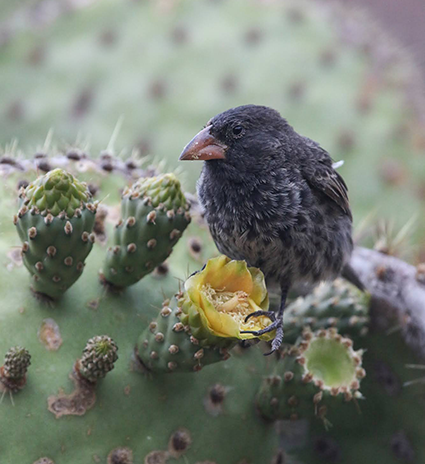An international team of researchers has released a landmark study on contemporary evolutionary change in natural populations. Their study uses one of the largest genomic datasets ever produced for a wild animal, comprising nearly 4,000 Darwin’s finches, to reveal the genetic basis of adaptation in this iconic group.
This study paints a dynamic picture of how species adapt to changing environments through a combination of genetic changes of large phenotypic effects that are sometimes transferred between species. As the global environment continues to change, the finches of the Galápagos islands will provide a valuable window into understanding how birds, their genetic constitution, and their environment interact to shape the future of wild populations.
The study was led by UC Santa Cruz postdoctoral scholar of Genomics & Bioinformatics Erik Enbody while he was studying at Uppsala University in Sweden, and was published in the journal Science today.
“I think it’s a really exciting opportunity to tie together our understanding of evolutionary change in the deep past with observations in current time,” Enbody said. “Genomic data is a powerful tool to take our observations of birds in the field and learn about the factors that have shaped their evolution by looking at their genomes.”
Ever since Charles Darwin wrote about the finches of the Galápagos Islands, biologists have studied these small songbirds to understand the mechanisms of evolution.
“The strength of Darwin’s finches as a model for evolution lies in what they can show about the early stages of speciation,” Enbody said. “On the Galápagos, one ancestral species has evolved into 18 different species in the last million years. One of the things that makes the finches such an amazing system is that we can observe evolution in real-time by measuring finch beaks and following individuals through their life.”
Biologists Peter and Rosemary Grant of Princeton University tracked nearly every individual on Daphne Major, an island in the Galápagos, starting in the 1970s. Their work demonstrates that the finches of Daphne Major evolved in response to changes in the environment and interactions among species. Now, an international team has sequenced the genomes of nearly every finch studied on Daphne and revealed the genetic architecture of adaptive change.
Enbody noted that his kind of study at this scale couldn’t be possible without decades of field research in the Galápagos.
“One of the remarkable things we found is that only a few genetic loci explain a great deal of the variation in the beak of the finch,” said Leif Andersson, a professor at Uppsala University and Texas A&M University and senior author of the study. “It seems that one of the ways these genetic changes evolve is by bundling together multiple genes into supergenes, which are then subject to natural selection as the environment changes.”
In fact, researchers found that 45% of the variation in the highly heritable beak size of Darwin’s finches can be attributed to only six genomic loci. One of these is a supergene that comprises four genes, which was under strong natural selection as a result of a two-year drought.
These results may surprise human geneticists because most gene variants associated with multifactorial traits like height and disease susceptibility only explain a tiny fraction of the heritable variation.
Study results found that over the three decades studied, the beak of the Medium Ground-Finch has become smaller. Using the genomes of all the finches on Daphne, the researchers show that this partially results from gene variants transferring from the Small Ground-Finch through hybridization and periods of drought between late 2003 and early 2005 where individuals with smaller beaks survived better.
“This study highlights the value of long-term studies to understand the mechanism of evolutionary change,” Peter Grant said.
The researchers collected a drop of blood from the wing vein and banded each bird.
“This allowed us to track them and determine how long they survived, who they mate with, and their offspring,” Rosemary Grant added. “By collecting blood samples throughout the study, we had the samples available for genomic study when the technology became available.”
The researchers studied not only the Medium Ground-Finch but the entire community of four species of finches present on the island. The Common Cactus-Finch experienced a gradual change towards blunter beaks as conditions on the island changed and hybridization with the Medium Ground-Finch increased.
Genome study reveals 30 years of Darwin’s finch evolution



